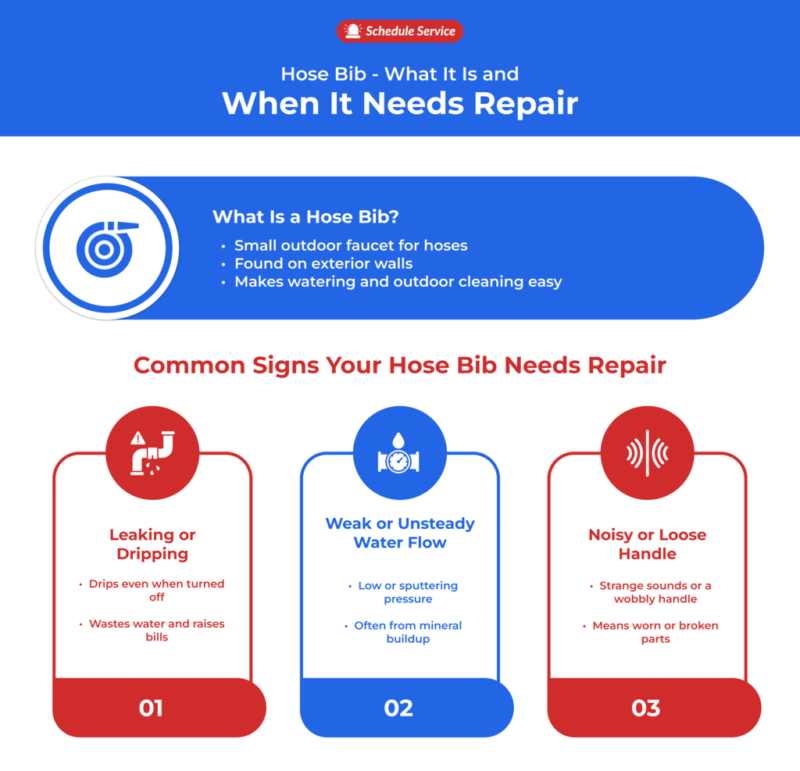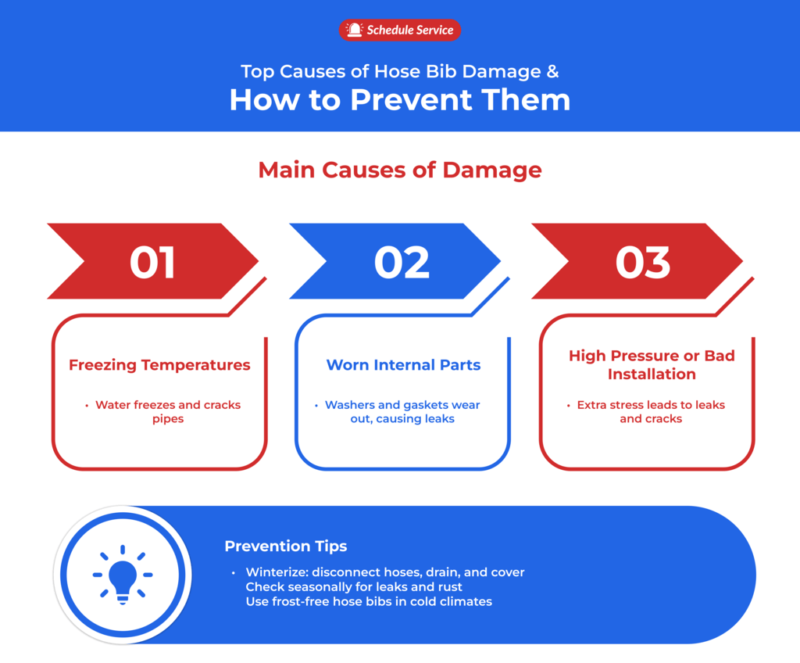What To Know About Hose Bib Repair
A hose bib may seem like a small detail on your home, but it plays a big role in making outdoor work easier. This outdoor faucet connects your hose to your home’s water supply so you can access water wherever you need it. However, over time, hose bibs can develop leaks, wear down, or even crack in cold weather. Therefore, it is important to know and spot early signs of trouble, common causes of damage, and repair the damage.
In this guide, you will find everything you need to know about hose bib repair, maintenance tips, and when to call in a professional.
What Is a Hose Bib?
Before jumping into hose bib repair, it is helpful to know what a hose bib actually is. A hose bib is a small outdoor faucet that connects your garden hose to your home’s water supply. You will usually find it on an exterior wall.
A hose bib makes it easy to water your plants, wash the car, or clean around the yard without bringing water from inside. It is designed for outdoor use, but it can wear out or start leaking over time. That is why it is important to understand how it works and when it is time to fix it.

Signs Your Hose Bib Needs Repair
Over time, your hose bib is exposed to constant sun, rain, and temperature changes, which can wear it down faster. However, when you spot early signs of trouble, you can avoid bigger plumbing problems and costly repairs later on.
Visible Leaks or Drips
A clear sign that your hose bib needs attention is when you see it leaking or dripping. These leaks often happen because of worn-out washers, damaged seals, or corrosion inside. These slow leaks can waste a lot of water over time and lead to higher water bills.
Apart from wasting water, constant leaking can also damage the wall or foundation around the hose bib. Over time, this moisture can lead to mold, staining, or other problems that are much harder and more expensive to fix.
Reduced or Inconsistent Water Flow
When the water coming out of your hose shows low pressure, it means there is a problem inside the hose bib. Sometimes, mineral deposits and sediment can build up over time and block the flow of water.
If you notice this happening, it is a good idea to have the hose bib checked as soon as possible. In some cases, the problem might be inside the pipes connected to the fixture, which can lead to more serious damage if you ignore it.
Unusual Noises or Loose Handles
Hearing strange noises when you turn on the hose bib is another sign that something is not right. These sounds usually mean that some internal parts are worn out or not working as they should.
Also, a loose or difficult-to-turn handle can mean that parts inside the hose bib have corroded or broken. When the handle feels loose, it might not seal properly, causing small leaks or making it difficult to control the water flow.
Causes of Hose Bib Damage
Because a hose bib stays outdoors year-round, it faces all kinds of conditions that can eventually lead to damage. Therefore, it is important to understand what causes this damage so that you can keep your hose bib in better shape.
Freezing Temperatures & Frost Cracks
One of the most common reasons a hose bib gets damaged is exposure to freezing temperatures. When water stays inside the hose bib, it can freeze and expand. This expansion can crack the fixture or the pipe leading to it.
Once the weather warms up and the ice melts, these cracks cause leaks and water damage around your home’s exterior wall. Therefore, in colder areas, it is recommended to use frost-free hose bibs to prevent these types of issues.
Worn Washers, Gaskets, or Packing Nuts
Over time, the small internal parts of a hose bib naturally wear out. For example, washers are important for creating a tight seal that keeps water from leaking when the faucet is turned off. However, with age, these parts become brittle, crack, or lose their shape.
When these seals no longer work properly, water starts to drip or leak around the handle. Make sure to regularly check and replace worn parts to extend the life of your hose bib and avoid bigger repairs in the future.
High Water Pressure or Improper Installation
Sometimes, a hose bib can also be damaged by high water pressure. When the pressure is too strong, it puts extra stress on all the internal parts and connections. Over time, this can lead to leaks, worn seals, or even cracks in the fixture itself.
Also, if the hose bib is installed at the wrong angle, over-tightened, or connected loosely, it can put unnecessary strain on the plumbing connections. This may lead to leaks or early failure of the fixture.
Repair vs. Replacement: What’s the Best Move?
When your hose bib starts showing signs, one question always comes up: Should you repair it or just replace the whole thing? The right choice can save you money, time, and a lot of frustration.
Here’s what you should consider before making the choice:
When Simple Repairs Are Enough
In many cases, small issues can be fixed with basic repairs. If your hose bib is leaking slightly, it might just need a new washer. Sometimes, tightening a nut or adding plumber’s tape around connections can stop a minor drip right away.
These repairs are usually quick and inexpensive, and they can extend the life of your hose bib without much effort. However, they only work when the fixture is still in good overall condition, and there are no cracks, severe corrosion, or serious mechanical failures.
When Full Replacement Is Necessary
There are times when a repair just is not enough. If you notice cracks in the body of the hose bib or the wall pipe leading to it, a full replacement is usually the only safe option. A crack means the fixture cannot hold water pressure properly anymore, which can lead to major leaks.
Sometimes, you may also have to replace it when the shut-off valve no longer works or if the handle feels completely stuck or broken. In these cases, small fixes won’t fix the main problem and could end up causing more damage later.
Cost and Time Comparison: Repair vs. Replace
When it comes to cost, repairs are always the cheaper option. Changing washers or tightening a few parts does not cost much and usually takes less than an hour. Even if you hire a plumber, small repairs are usually affordable.
On the other hand, a full replacement costs more money and takes more time. You need to buy a new hose bib and some extra parts. Replacing it can take a couple of hours, especially if the old fixture is hard to reach. However, if your hose bib keeps leaking, replacing it can actually save you money in the long run because it helps avoid bigger problems later.
How Hose Bib Repair Is Done
When your hose bib starts leaking or showing signs of wear, fixing it might seem difficult at first. But many smaller issues can be handled on your own with some basic tools.
Tools & Materials Needed
Before you start, gather all the tools and supplies you need to make sure you have all the items around. Here are some common items you are going to need:
- Adjustable wrench
- Replacement washers
- Teflon tape
- Pipe dope
Step-by-Step DIY Overview
If your hose bib is leaking, you can often fix it yourself using some basic tools. Follow these steps carefully to make the repair easier and safer.
Step 1: Turn off the Water Supply – Before you start, turn off the water supply to the hose bib. Once the water is off, open the hose bib outside to drain any leftover water.
Step 2: Tighten the Packing Nut – Sometimes a leak can be fixed by simply tightening the packing nut behind the handle. Use a wrench to turn it gently about a quarter turn. Be careful not to overtighten, as this could damage the parts.
Step 3: Remove the Handle and Check the Washer – If the leak continues, remove the handle. Then, use a wrench to loosen and remove the packing nut. Check the washer at the end. If the washer looks worn out or damaged, replace it with a new one.
Step 4: Wrap Threads and Reassemble – Before putting everything back, wrap Teflon tape around any threads. This helps seal the connections and prevents future leaks.
Step 5: Turn the Water Back On and Test – Turn the water supply back on slowly. Check the hose bib to make sure there are no drips or leaks.
When to Call a Professional Plumber
While many hose bib repairs are simple and can be done yourself, there are times when it is better to call a professional plumber. If you see cracks in the wall pipe or notice that the whole fixture is damaged, these are signs of a bigger problem. These issues are not easy to fix on your own.
Also, repairs that involve pipes inside the wall, soldering, or large leaks should always be handled by a plumber. A professional can make sure everything is properly sealed and safe, helping you avoid water damage and giving you peace of mind.
Preventative Tips to Avoid Future Hose Bib Issues
Apart from repairing or maintaining it, taking care of your hose bib before problems start is the best way to keep it working smoothly for years. With careful planning and regular upkeep, you can avoid leaks, cracks, and other costly surprises.

Winterizing Your Outdoor Faucets
In colder areas, freezing temperatures can easily damage a hose bib if it is not properly winterized. As temperatures drop, any water left inside the fixture or connected pipe can freeze and expand, causing cracks and leaks once it melts.
Therefore, before winter sets in, it is important to disconnect any attached hoses and drain all remaining water from the hose bib. Shut off the water supply to that line, and leave the faucet open to allow any leftover water to escape.
Seasonal Maintenance Checklist
Keep an eye on your hose bib throughout the year to catch small issues before they turn into bigger problems. At least once each season, check for any signs of leaks around the handle. If you see any dripping, it might just need a new washer or a tightening of the packing nut.
It is also helpful to make sure the fittings are sealed properly and look for any rust or mineral buildup. A little maintenance a few times a year can make a big difference in extending the life of your hose bib.
Upgrading to Frost-Free Hose Bibs
If you live in a place with very cold winters, it is better to replace your regular hose bib with a frost-free hose bib. This type has a longer stem that extends further into your wall, and a shut-off valve is placed inside, away from the cold air. Because of this design, it is much less likely to freeze or crack when the weather gets really cold.
However, installing a frost-free hose bib can be a bit more complicated than a regular one, so it is recommended to hire a plumber to do it. It may cost more at first, but it helps protect your outdoor water system and saves you from future repairs.
Get Reliable Hose Bib Repair Help
If your hose bib is leaking, cracked, or just not working the way it should, it is important to get it fixed quickly to avoid bigger plumbing problems. Some minor issues can be handled on your own, but there are times when calling an experienced professional is the best choice.
Why Choose I Need A Plumber Now
I Need A Plumber Now is a trusted local team that understands what homeowners in the Puget Sound area need. With almost 20 years of experience, we have built a strong reputation for being reliable, honest, and quick to help. Our company is fully licensed, insured, and bonded, so you can feel safe knowing your home is in good hands. Our skilled team uses professional tools to handle all types of jobs and always takes the time to explain the work and share tips to help you avoid future issues.
Schedule Your Hose Bib Repair Today
Schedule your hose bib repair with us today and enjoy fast, reliable service whenever you need it!
Frequently Asked Questions
Can I repair a hose bib myself?
Yes, many small hose bib repairs can be done yourself, if it’s a simple fix like replacing a washer or tightening a packing nut. However, if you notice cracks in the fixture or pipes inside the wall, it is better to call a professional plumber.
How much does a hose bib repair usually cost?
The cost to repair a hose bib can vary, but simple fixes are usually not expensive. Replacing washers or tightening parts might only cost a few dollars. However, a full replacement, especially if it involves wall pipes or upgrading to a frost-free model, will cost more.
What’s the difference between a regular and frost-proof hose bib?
A regular hose bib has a shut-off valve close to the exterior wall. On the other hand, a frost-proof hose bib has a longer stem that extends into the interior part of your home, keeping the valve away from freezing air.
Is it bad to leave a hose connected during winter?
Yes, leaving a hose connected during winter can trap water inside the hose bib and pipes, which can freeze and expand. This increases the risk of cracks and leaks once temperatures drop.
How long should a hose bib last?
A well-maintained hose bib can last 10 to 20 years or even longer. Regular maintenance, such as checking for leaks, replacing worn washers, and winterizing properly, can help extend its lifespan and keep it working smoothly.





